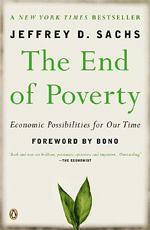Jeffrey D. Sachs is the Director of The Earth Institute at Columbia University and internationally renowned for his work over the past three decades as economic adviser to governments around the world. Sachs begins this trenchant paperback with the statistic that more than eight million people around the world die each year because they are too poor to stay alive. He goes on:
"Every morning our newspapers could report, 'More than 20,000 people perished yesterday of extreme poverty.' The stories would put the stark numbers in context — up to 8,000 children dead of malaria, 5,000 mothers and fathers dead of tuberculosis, 7,500 young adults dead of AIDS, and thousands more dead of diarrhea, respiratory infection, and other killer diseases that prey on bodies weakened by chronic hunger. The poor die in hospital wards that lack drugs, in villages that lack antimalarial bed nets, in houses that lack safe drinking water. They die namelessly, without public comment. Sadly, such stories rarely get written. Most people are unaware of the daily struggles for survival, and of the vast numbers of impoverished people around the world who lose that struggle."
British economist John Maynard Keynes wondered in 1930 how the society of his grandchildren would use its wealth and its unprecedented freedom from the age-old struggle for daily survival. Sachs believes that despite the staggering odds, this generation can end extreme poverty by the year 2025. It will take "a common bond of humanity, security, and shared purpose across cultures and regions" to lift the burdens of the one billion people subsisting on $1 a day.
In a chapter called "A Global Family Portrait," Sachs comments on economic development in four places: Malawi, Bangladesh, India, and China. He then briefly charts 200 years of modern economic growth and reveals why some countries fail to thrive and remain stuck in the poverty trap. The most fascinating chapters cover China's great leap forward, India's amazing economic growth, and the many challenges facing African nations. The author believes that key investments in people and infrastructure can give impoverished nations the tools they need for sustainable development.
Sachs outlines the UN Millennium Development Goals based on poverty reduction and talks about the myths and magic bullets that becloud people's vision when they think about ending poverty. He ends with a nine-step program to end extreme poverty which includes raising the voice of the poor, redeeming the role of the United States, strengthening the United Nations, and promoting sustainable development.
